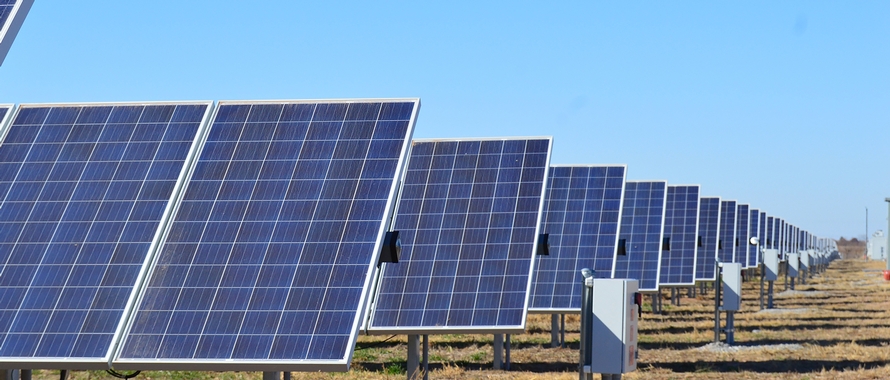Going Solar?
Solar forecasts can be misleading. Talk to your co-op before you go solar.

When Phil Puckett retired from the military in 2014, he and his wife settled into a 4,000-square-foot rural home east of Lawton with a swimming pool and a stable for their horses. A longtime supporter of renewable energy, the 61-year-old says he follows industry advancements with great interest. He finds the idea of being sustainable and self-reliant appealing, along with the potential energy savings. Witnessing the 70% price drop in residential photovoltaic (PV) panels since 2010, Puckett decided it was time to go solar.
After meeting with several solar representatives, the Pucketts settled on a company they loved.
“We were absolutely going to pull the trigger at $110,000, which would cover the house, barn, pool, everything,” Puckett recalls.
According to the company’s estimates, going solar would reduce the Pucketts’ electric bill by 60%.
“That was a big deal for us since we pay around $600 a month for electricity,” he says.
State regulations require grid-tied PV systems to be reviewed and approved by the current electricity provider. Project specs in hand, Puckett stopped by Cotton Electric Cooperative in Walters, where he sat down with Heath Morgan, co-op energy use adviser. The system design looked satisfactory, but Morgan noticed a few irregularities in the solar estimate, an inflated residential per kilowatt-hour rate being one. He suggested taking a closer look.
“I’m glad he did because we realized the savings wasn’t close to what they predicted. We would’ve dumped a lot of money into this project, and it would’ve taken 20 to 30 years to pay for itself. At that rate, we wouldn’t live long enough to see any return,” Puckett says.
Radiant Expectations
Puckett’s experience is a familiar one among Oklahoma’s electric co-ops. Members eager to reduce their home energy costs invest in an expensive rooftop solar system that falls short of the savings forecast by eager sales reps. Most co-ops don’t hear about the problems until it’s too late.
“By then, they’re unhappy, and they call us wanting to know why they aren’t saving as much as they expected,” Morgan laments.
A simple solution: Get your co-op involved before making a decision. Morgan understands why some don’t.
“They think we are anti-solar, but we aren’t. We’re very pro-solar, especially at the utility scale. What we’re against is our members being misled,” he says.
Co-ops Know Solar
Co-op use of renewable energy is well chronicled in the power purchase agreement of the state’s largest cooperative-owned generation and transmission utility. In 2003, Western Farmers Electric Cooperative (WFEC) signed its first-ever power purchase agreement for wind energy with Blue Canyon Wind Farm. At the time, it was the largest purchase agreement for wind energy in Oklahoma. Today, WFEC is partnering to build the largest wind, solar, and battery storage facility (being built in one location) in the nation. An average of 35 to 40 percent of WFEC electricity sold is generated using renewables, primarily solar and wind.
Across the U.S., co-op-owned solar arrays help offset power costs while serving as education tools for their communities. Cotton Electric’s 950-panel array is one of 11 co-op-owned community solar projects in Oklahoma.
“We understand how solar works because we have experience with it. We also have several years of solar production data that can help our members get a better idea of what their panels will reliably produce,” Morgan says.
Many factors can affect the efficiency of a rooftop system—the pitch of the roof, position of the sun, performance quality of the panels, surrounding landscape including trees, buildings and other obstructions, atmospheric conditions, and weather. A home’s efficiency and the homeowner’s lifestyle also come into play.
“Some people think they can ignore their usage when they go solar, but that’s not the case. Their energy use habits, how well their home is insulated, these things still matter whether the electricity comes from solar panels or the power plant,” Morgan points out.
Because residential energy use can fluctuate significantly based on unpredictable factors, Morgan always looks at five years of electricity use to create the best estimate based on homeowner habits and local weather patterns over time.

NOAA Solar Calculator website and the
PVWatts Calculator website
Honest Buyback
One of the first things consumer-members ask is what the co-op pays for the excess power a residential PV system generates. Because solar members still benefit from the grid, they are expected to pay basic customer charges and fees that cover grid maintenance expenses. Consumer-members should check with their local cooperative for buyback specifics.
At CKenergy Electric Cooperative in Binger, co-op members with solar questions find their way to Boyd Lee, vice president of strategic planning.
“If it were any other way, our regular members would end up subsidizing our solar members,” Lee explains.
Before diving deep into the pros and cons of rooftop PVs with a member, Lee determines their primary motivation for going solar.
“If they’re going solar because they want to do their part for the environment, I say, ‘Great, go for it.’ If they’re doing it because they think it’s going to save them a bunch of money, that’s when I tell them they might want to take a second look,” he says.
Lee recommends solar-curious homeowners use the online PV calculators provided by the National Renewable Energy Laboratory (NREL), and the National Oceanic and Atmospheric Administration (NOAA). Checking the solar company’s credentials is wise, he adds, and it doesn’t hurt to ask the salesperson about their previous job experience. “If they were selling cars last week and this week they’re a solar energy expert, that might be a red flag,” he says.
While Lee knows of no bad apples among his solar contacts, he has encountered his share of inexperienced sales reps. “Many of them are fresh out of training, and they simply aren’t knowledgeable about the complexities of utility rates or solar energy production, for that matter. It’s not a one-size-fits-all deal,” he says.
Outlook Sunny
Back in Lawton, Phil Puckett admits he was mildly disappointed when his project fell through, but it won’t sour him on solar energy. Investing in a residential PV system may not make economic sense for the average Oklahoman today, but tomorrow it might, he says.
In the meantime, Boyd Lee and his co-op cohorts claim there’s another way for members to save energy and the earth. “Twelve hundred dollars worth of insulation in your attic and $10,000 to $12,000 for geothermal heating and cooling will make your home warmer in the winter, cooler in the summer, heat your water, and save you as much or more than solar for less than half the investment,” Lee says. “Right now, geothermal beats solar every time.
Sign up for our Oklahoma Living Newsletter


